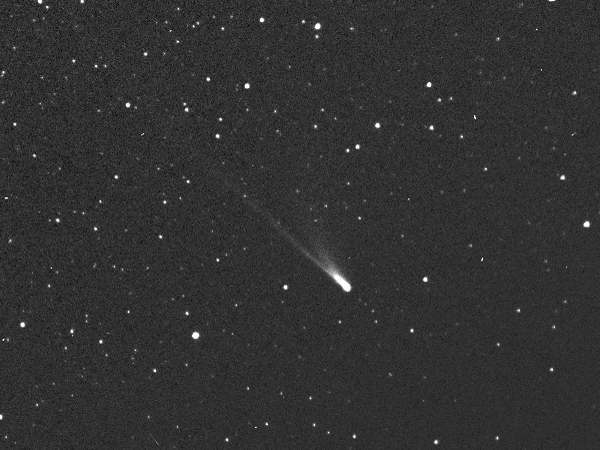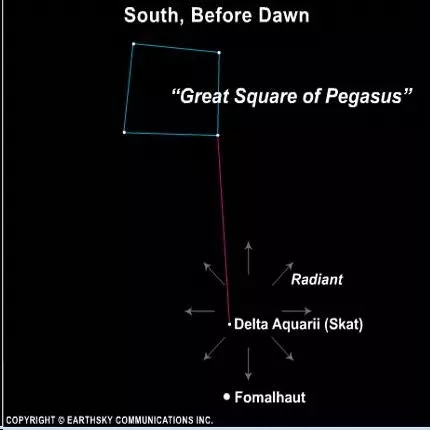Jul 28, 2017
The Delta Aquariid shower begins around mid-July. The nominal peak is July 28 or 29. The shower is long and rambling. So if you watch the Perseids in August, you might see a few Delta Aquariids then, too.
Late July 2017 – around July 27 or 28 – presents the nominal peak of the Delta Aquariid meteor shower, but this long-lived meteor shower rambles along steadily from about July 12 to August 23 each year. The full moon on August 7, 2017 means rather wide waxing crescent moons at and near the peak dates of July 27 and 28. Fortunately, the moon will set at late evening, to provide moon-free skies between midnight and dawn. Typically, this shower produces the most meteors in the predawn hours and overlaps with the more famous Perseid meteor shower. So you might see a few Perseids in the mix.
When and how should I watch the Delta Aquarid meteor shower? Does this shower have a peak? It does have a nominal peak in late July. This year, in 2017, the rather wide waxing crescent moon doesn’t seriously intrude on the peak dates of July 27 and 28. The moon will set before midnight, but the best viewing hours are after midnight and before dawn, centered around 2 a.m. (3 a.m. Daylight Saving Time) for all time zones around the world.
The Delta Aquarid meteors tend to appear a bit fainter than the Perseids and meteors seen in other major showers. That makes a dark sky free of moonlight even more imperative for watching the annual Delta Aquarid shower.
The Delta Aquarid shower is said to favor the Southern Hemisphere. But viewers at mid-northern latitudes will see plenty of these meteors. In years when the moon is out of the way, the broad maximum of this shower can be expected to produce 10 to 20 meteors per hour, under a dark country sky.
About five to ten percent of the Delta Aquarid meteors leave persistent meteor trains – glowing ionized gas trails that last a second or two after the meteor has passed. The meteors burn up in the upper atmosphere about 60 miles (100 km) above the Earth’s surface. Watch for their lingering trains!
Radiant point for Delta Aquarid shower is near star Skat, or Delta Aquarii. This star is near in the sky to a much brighter star, Fomalhaut, which can be found roughly on a line drawn southward through the stars on the west side of the Great Square.
How can I tell Perseid meteors from Delta Aquariid meteors? This is where the concept of a radiant point comes in handy. You never have to locate a shower’s radiant point to enjoy the meteors. But … if you trace all the Delta Aquariid meteors backward, they appear to radiate from a certain point in front of the constellation Aquarius the Water Bearer. As viewed from the Northern Hemisphere, this point – the Delta Aquariids’ radiant point – arcs across the southern sky. It’s overhead for Southern Hemisphere viewers (which is why the shower is best from that part of the world).
The radiant point of the Delta Aquariid shower nearly aligns with the star Skat (Delta Aquarii). The meteor shower is named in honor of this star.
Meanwhile, the Perseids radiate from the constellation Perseus, in the northeast to high in the north between midnight and dawn, as seen from the Northern Hemisphere. So if you’re in this hemisphere, and you’re out watching for meteors, and you see meteors coming from the northeast or north … they are Perseids. If you see them coming from the south … they are Delta Aquariids.
If you’re in the Southern Hemisphere, your Delta Aquarids will be radiating from nearly overhead. Your Perseids will be shooting up from somewhere along your northern horizon.
In a particularly rich year for meteors, if you have a dark sky, you might even see Perseid meteors cross paths with Delta Aquariid meteors! It can be an awesome display.
 Comet 96P Machholz, the possible parent of the Delta Aquarid
Comet 96P Machholz, the possible parent of the Delta Aquarid
meteor shower, was discovered on May 12, 1986, by Donald
Machholz. Photo: Wikimedia Commons
Delta Aquarid meteors may come from Comet 96P Machholz. Meteor showers happen when our planet Earth crosses the orbital path of a comet. When a comet nears the sun and warms up, it sheds bits and pieces that spread out into that comet’s orbital stream. This comet debris slams into the Earth’s upper atmosphere at about 90,000 miles (150,000 km) per hour, vaporizing – burning up – as meteors or shooting stars.
The parent body of the Delta Aquarid meteor is not known with certainty. It was once thought to have originated from the breakup of what are now the Marsden and Kracht sungrazing comets. More recently, the Comet 96P Machholz has loomed as the primary candidate for being the Delta Aquarids’ parent body.
Donald Machholz discovered this comet in 1986. It’s a short-period comet whose orbit carries it around the sun once in a little over five years. At aphelion – its greatest distance from the sun – this comet goes out beyond the orbit of Jupiter. At perihelion – its closest point to the sun – Comet 96P Machholz swings well inside Mercury’s orbit.
Comet 96P/Machholz last came to perihelion on July 14, 2012 and will next come to perihelion on October 27, 2017.
Bottom line: The Delta Aquarid meteor shower rambles along pretty steadily in late July and August, coinciding with the Perseids. From any time zone, the best viewing window is centered on roughly 2-3 a.m. Find an open sky away from artificial lights, lie down on a reclining lawn chair and look upward. In 2017, the prospects for watching the Delta Aquarids in late July are very good, with no moonlight to ruin the predawn show.
Image: Radiant point for Delta Aquarid shower is near star Skat, or Delta Aquarii. This star is near in the sky to a much brighter star, Fomalhaut, which can be found roughly on a line drawn southward through the stars on the west side of the Great Square. - EarthSky.org
Share this article with friends!
Tags:
#delta#aquarlid#shower,#strz#astrologers,#starzpsychics.com,starz#advisors


